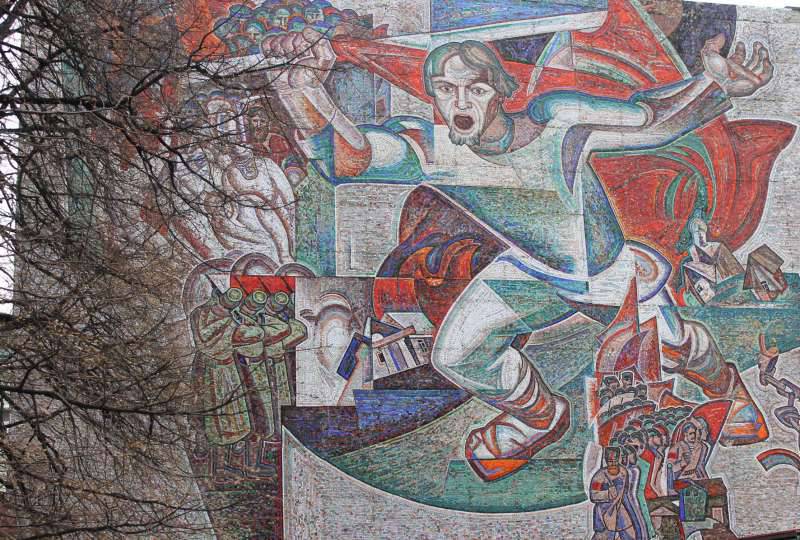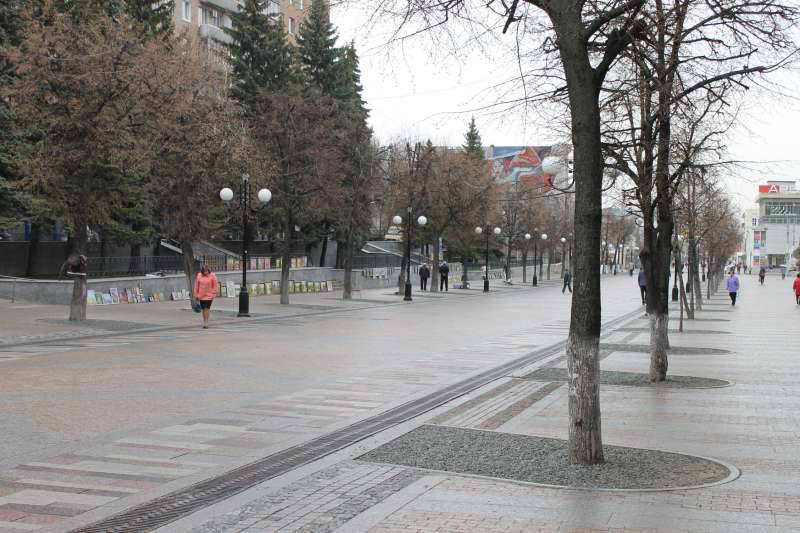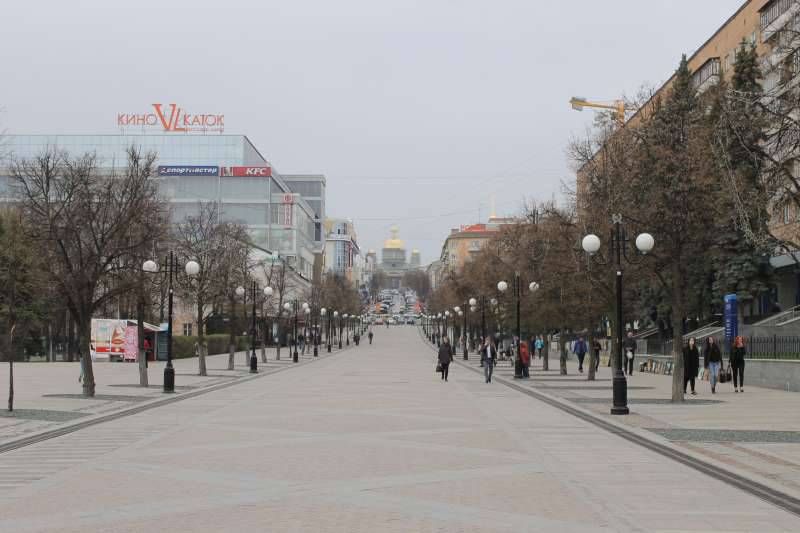The memory of Kandiyevka: “the streets are our brushes, the squares are our palettes”
“Pretty penny truths.
From the heart of the old wipe.
The streets are our brushes.
Squares are our palettes.
A thousandth time book
Revolution days are not glorified.
On the streets, futurists,
drummers and poets! ”
V. Mayakovsky "Order on the army of art"
At first glance, the episodes of V. Mayakovsky carried to the epigraph are of little concern to one of the most ancient and traditional types of pictorial art, and are more suitable for avant-garde techniques. But it was precisely the monumental forms of art in post-revolutionary Russia, and then in the USSR, because of the wide possibilities of clarity, panoramic character, collectivity of performance, were widely in demand.
Mosaic is called eternal painting, not only because of its more than five thousand years stories. It has special, different from other types of monumental painting properties: the mosaic is utilitarian and decorative, multifaceted and complex, at the same time addressed and understood by the masses, narrative and symbolic, able to absorb the latest achievements of art and keep in touch with traditions. In 1920-30 laconic mosaic graphic means conveyed the very essence of the revolutionary atmosphere.
Here it is - a close-up narrative and symbolic mosaic.
But mosaic decoration was especially popular in the town planning of the USSR, starting with the 1960s. If earlier the architecture of the Stalinist Empire style took on the aesthetic elocutive function, then with the entry into force of the Resolution of the Central Committee of the CPSU and the Council of Ministers of the USSR "On the elimination of excesses in design and construction" from November 4 of 1955, priority was given to the ascetic simplicity of constructive solutions. “Unjustified tower superstructures, numerous decorative colonnades and porticos” were recognized as overkill, and “simplicity, rigor of forms and cost-effective solutions” were recommended.
The typical building with prefab panel houses allowed to move to the first place in the decoration of monumental painting buildings. As in antiquity, it connected spatial arts into a single image - figurative and architecture, which made it possible to call it a synthesis of arts.
Geometric surfaces deprived of “excesses” could take monumental works in a variety of configurations, which, in fact, was their only decoration. Monumental panels played the role of accents in the text of the synthetic artistic work of the massifs of new buildings - these were pauses, caesuras, markings; they compensated for the general monotonous rhythm of the buildings. Such “art of neighborhoods”, looking into the courtyards, and not at the main avenues, has become a completely new practice of 1960-80's. There was even a specific term denoting this design style of residential buildings, and, more precisely, their lateral sides (ends) - "torment".
By the year 1968, by the 50 anniversary of the Leninist plan of monumental propaganda, that is, put forward by V.I. Lenin in 1918, the strategy of the development of monumental art and its mobilization for visual agitation, monumental art became the hallmark of the all-union style, the flourishing and monumental mosaic began. Despite the fact that it was mainly a matter of monumental sculpture, the USSR Union of Artists announced the “revitalization of monumental propaganda and the development of the synthesis of monumental-decorative arts in urban planning”. The Khrushchev Renaissance chose a time-consuming, durable and expensive mosaic not by chance. Mosaic art is typical of the “sixties” interpretation of history, typically with its citizenship, a certain narrativity and publicism.
Since 1960-s in the USSR, the system of urban planning management is changing. 17 October 1969 was approved by the Council of Ministers of the USSR Regulations on the USSR Ministry of Construction, which was supposed to manage the construction of industrial enterprises, buildings and structures, residential buildings and cultural and community facilities. A special role in the management of construction belonged to the Union-Republican State Committee of the USSR for Construction Affairs (Gosstroy of the USSR), which, in accordance with the resolution of the Central Committee of the CPSU and the USSR Council of Ministers of July 12, was responsible for implementing a unified technical policy in construction, improving the design and budget business , improving the quality of design; and also for the improvement of the architectural appearance of cities, industrial centers and villages.
The architectural appearance of the union, republican and regional centers is gradually changing, more and more attention is being paid to their artistic design. When designing a public or production facility, they began to devote two percent of the total budget to it. At the same time, the decoration was created not according to one template, but according to unique sketches.
In the same period, Penza, like most regional centers, began to change. The monumentalists of 1960, undoubtedly, had a difficult task - to change the flat and dull wall space, using illusory, perspective cuts. I must say that they did a lot for that time: they brought the painting to the exterior, introduced new materials, began to use color widely, combine painting with reliefs (both authentic and illusory, pictorial).
By 1970, Penza already had a half or two dozen mosaics, but the most famous, located in the heart of the city on the street. Moskow became the mosaic "Kandievsky Uprising".
The theme of the mosaic panel is devoted to the events of the peasant uprising of the beginning of April 1961 of the year (2-18 of April), caused by the reform of the abolition of serfdom and which became a reaction to the content of the February 19 1861. This uprising was not the only one, but it was the most large-scale such event , along with unrest in the Kazan province in the village of Abyss.
Although the uprising was crushed in 15 days, it left a symbolic mark. For the first time in the history of the country during the Kandievsky peasant uprising, the Red Banner was raised as a symbol of struggle. This moment is captured on the mosaic panel "Kandievsky Uprising".
The initiator of the perpetuation of the largest peasant uprising against the conditions for the abolition of serfdom in Russia was the second secretary of the CPSU Regional Committee Georg Vasilyevich Myasnikov, who invited Moscow artists to Penza. The Moscow “artist of two-dimensional space”, as recorded in the “Register of Professional Artists”, that is, the monumental artist Mikhail Alekseevich Trunkov, became the head of the works and the author of the panel's sketch. He studied at the Moscow Higher School of Industrial Art (formerly Stroganov) under S. V. Gerasimov, A. I. Kuprin, G. I. Opryshko, V. E. Egorova. He is a member of the Union of Artists of the USSR since 1956. Mikhail Alekseevich is known for his paintings in Moscow: at the Slava cinema, with stained glass windows and mosaics at the Molodezhnaya hotel, and mosaics at the Sokolniki training center. The master worked not only in Moscow, but also in Yaroslavl, Volgograd, Pyatigorsk. At the moment his works are kept in many museums of the country and abroad.
In Penza, Mikhail Alekseevich Trunkov not only made the mosaic "Kandievsky Uprising", but also decorated the reliefs of the facade of the former Regional Drama Theater. A. V. Lunacharsky, reliefs and mosaics in the building of the railway station, mosaics in the building of the Aeroflot ticket office.
Along with monumentalism, Mikhail Alekseevich has been engaged in easel painting in recent years. But it also shows the artist’s skillful mastery of the space and the plane, inherent in the monumentalist, enriched by the skill of the colorist painter. The artist does not leave the monumental art, and in 1998-1999 (in 73 of the year!) He worked on the restoration of the picturesque decoration of the Cathedral of Christ the Savior in Moscow, where he created figures of evangelists as part of artistic groups.
Monumental art is not only collectively in content and addressee, but also in execution, it is the result of collective creativity, and not the art of one person. The groups included the author or authors of the sketch and performers. All of them usually remained unknown. It is not by chance that the mosaic was widely used in medieval art - “nameless art”, when “the divine and the common have priority over the individual person”. But if in rare cases the mosaic was accompanied by a sign with credits, few people remembered the authors. That is, the monumental paintings were not an exhibition of individual talents, but an exhibition of generalized talented Soviet reality. The very idea of the primacy of the public over the private, and the mosaic as a form of its expression could not be more consistent with the communist ideology.
Work on the creation of the panel "Kandievskoe Uprising" began in the year 1971. After the approval of the future mosaic sketch on the artistic council, Mikhail Alekseevich Trunkov, like many centuries before him, the master of the Renaissance, began to perform work on cardboard in full size. Initially, it was supposed to finish the panel for the 110 summer anniversary of the Kandievo Uprising, but due to the complexity of the work (only installation lasted about a year), its official opening took place on the eve of the October holidays in 1973.
The works were performed by employees of the Moscow Design Arts Works. The collective nature of mosaic execution (as well as monumental painting in general) is obviously related to the scale and laboriousness of the work - thus, the Kandia Rebellion panel occupies 130 square meters of space.
Monumental art 1960-x revived or created a large number of techniques of performance of works: smalt, ceramic, stone mosaic with different options for masonry, graffiti, reliefs, wrought-iron lattice, stained glass and others.
According to the technique of execution, the Kandievo Uprising panel is a reverse mosaic set, which is used in complex mosaics of a large area. This is a smalt mosaic, which was used to create 6,5 tons of colored glass - smalt, welded in a special way. Smalt, one of the relatives of Murano glass, is colored opaque glass, interesting because, although it is opaque, it seems to glow from the inside. For a long time, Smalt was a traditional church material, which for centuries kept the reputation of the precious, rare and elite. From 1960's, it spread throughout the USSR, including small towns and distant villages. Unknown collective farmers, miners and scientists began to be portrayed in the same technique in which Christ, the Mother of God, the saints, and royal persons were imprinted in the “bibles for the illiterate”. The routineization of the mosaic has become an egalitarian appropriation of a technique formerly belonging only to the elite.
But not only the technique of the performance of the Krandiev mosaic refers us to the past: the composition shows the tradition of writing the icons of hagiography, known from the 9th century. In the center (middle part) there was an image of the saint, around the perimeter of the icon - the stigma, located and “readable” from left to right, representing the history of his life and miracles. In stamps, the plot develops in time: on the left — during the life of the saint, on the right — after his death; but the central figure is timeless. The saint is portrayed as the winner, having overcome the earthly trials, and the stigma is a wreath of Glory.
Because of the technical problems associated with the placement of the “Kandievsky Uprising” panel, two parts stand out, but we see the same general idea of the living composition. In the center of the first part of the panel is a stylized image of a giant peasant, having the illusion of relief, around which a hierarchy of rhythmic relations is built. The prototype of the artist could serve as Leontiy Egortsev, one of the leaders of the uprising. He holds the Red Banner above himself (and, perhaps, the sword) - a symbol of the struggle, and calls on the peasants from the surrounding villages to fight for freedom. The picturesque form of the panel is textured, rich in theatrical entertainment, external effects, but unusually artistic. Symbolically, this is no longer the victory of one saint, not an image of one person, but a timeless display of the triumph of the driving forces of history in a generalized and understandable image.
As in the living icon, we read the story from left to right: the left upper group of rebels shot by soldiers along a conventional line through the giant’s entire body, through the sharp corners of the banner and fire, is connected to the lower group of people lining up shoulder to shoulder. Mosaic because of its features does not allow, like easel painting, to convey emotions through facial expressions (except for the most ambitious figures), it operates with lines and silhouettes, angles of figures, masses, which create an emotional plan.
The artist chooses the climax of the uprising - a clash with the regular forces of the royal army. The moment itself is tragic, and this is conveyed by artistic means: the giant's mouth is open in silent shouting, broken falling figures of the dead, slouched small, in relation to the rebels, figures of soldiers preparing to shoot, the mass of marching create a dense fabric of the narration and emotional tension. Anxiety and drama of the moment are underlined by graphic means: fractional geometric rhythm, irregular rectangles, truncated pyramids, located in horizontal and vertical planes.
You can pay attention to the collage principle used in the panel, sudden drops in scale. Used not real, but semantic scales, as in ancient art. Since the compositional center — the giant — dominates everything, the arrangement of the compositional groups at the focal points of attention along the S-shaped sight trajectory allows the history of all other participants to be seen by the viewer too.
The mosaic is almost invisible behind the greens of spruce and linden. Is only the head and a piece of the banner.
The mosaic itself is traditionally static, but the compositional techniques used by the artist tell her the internal dynamics, despite the symmetrical composition. Diagonals and their intersections, graphic geometric forms based on two unstable triangles (on the sides of the central figure) give dynamism to a static mosaic, link the figures into one compositional whole. The dynamism of the generalized central character is underlined by his figure - a slanting cross in the geometry of forms. It rests on a conventional circle - this is the earth, on it are visible falling houses, a crooked church; its motion is the rotation of the earth; he leaves behind broken chains and attributes of the old world.
The symbolism of the plot with all the large number of derived figures (there are about 60) is expressed very clearly and coherently. Both external and internal human movements are transmitted strongly, expressively and naturally.
Mikhail Alekseevich Trunkov skillfully used mosaic to convey volume, light, shadows and space. Color serves as a defining element, the whole composition is built on a combination of bright local color spots. The basis of the coloristic expressiveness is the large color planes and the linear contours of the figures, the symbolism of color: red is both the first red flag raised and the glow of a fire rising on the ground.
In addition to the iconographic stylistics noted by us in the Kandievsky Uprising mosaic, one can note the influence of a “stern” style, even avant-garde tendencies, which corresponds to the peculiarities of 1970's art, marked by a polystylism, based on the interaction of artistic languages, which led to aesthetics emerging postmodernism.
The simplicity of the plot, generalization with emotionality and sharpness of the most characteristic image, the magnitude of the idea and the historical significance of the topic, the skill of execution made the mosaic “Kandievsky Uprising” an object of Penza’s cultural heritage. The panel is entered in the registry number 5800000701. However, the monument is not enough to make a register, it is subject to protection, but at the moment the state of the panel is alarming. This most famous and most impressive Penza mosaic, from the opening of which in 2016 was performed on 43, quickly collapses: pieces of smalt fall out, right and upper left corners collapse, seams are exposed.
Meanwhile, it is worth remembering the federal law “On the objects of cultural heritage (monuments of history and culture) of the peoples of the Russian Federation”, according to which such monuments “are of unique value for the entire multi-ethnic people of the Russian Federation and are an integral part of the world cultural heritage”. They are guaranteed by law safety. Nevertheless, the panel continues to collapse rapidly, crammed by the restaurant located directly below it.
View of the pedestrian part of Moscow street and the cathedral under construction. Now this building is a symbol of the era ...
Well, the mosaic panel about which we told here, in general, is also a sign of the epoch which has gone and will never return.



Information